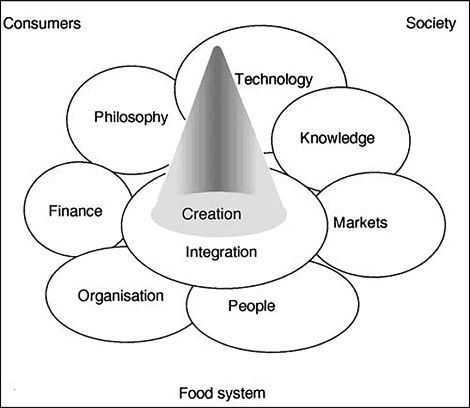FOOD
PRODUCT DEVELOPMENT
Mary Earle, Richard Earle and Allan Anderson |
| Loading
|
|
||||
|
|
Part 2, Chapter 2
Developing an innovation strategy 2.1 Possibilities for innovation Innovation is an integral part of society, and therefore an integral part of an industry and a company. There are three basic principles of innovation:
1. An innovation is an idea perceived as new by the individual (Rogers, 1962). 2. An innovation causes change, which can be technological or sociological but is probably a combination of both (Earle, 1997). 3. An innovation involves a wide range of people, in the company, the company's environment and the society (Earle, 1997). Innovation is seen as the state of mind in the company (Kuczmarski, 1996). The traditional definition of innovation in companies as product development and process development has expanded to include all the other changes that can occur (Voss, 1994). Innovation can include ideas for different changes - philosophy, technology, methods, organisation, market, people. But it is important for the company to recognise that any of these changes will affect not only the company but also the other organisations in the food system, the consumers and the society. Innovations outside the company also cause changes inside the company; for example, the technological innovation of the supermarket changed food manufacturing and marketing, the social change of more women working caused an increase in convenience foods. So innovation is related to the climate within the company and also that surrounding it in the food system and the society as shown in Fig. 2.2.  Fig. 2.2 Climate for innovation. It is important to observe the changes already occurring outside and inside the company, and to predict the possible changes that can achieve the aims of the company to survive and grow. One of the great difficulties is to differentiate between the true, long-term changes and 'fashions' which die quickly. Judging wrongly may adversely affect the company. The rate of innovation in a company depends on its ability:  to sense possibilities and to perceive and assess the likely outcomes to sense possibilities and to perceive and assess the likely outcomes of feasible changes;  to evaluate and rank such outcomes strategically and operationally, in to evaluate and rank such outcomes strategically and operationally, in
relation to company objectives;  to make decisions on the basis of such information and prepare to make decisions on the basis of such information and prepare appropriate strategies;  to implement plans and changes in managerial and technical terms to implement plans and changes in managerial and technical terms (Frater et al., 1995). These steps are shown in Fig. 2.3.  Fig. 2.3 Innovation chain. |
|
 |